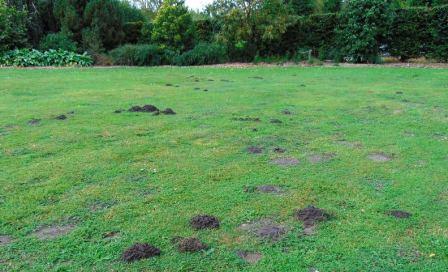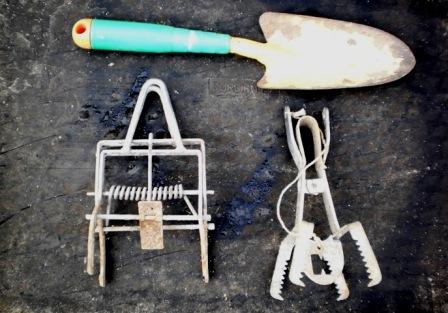Moles eat 40 to 50 grams of insects per day, approximately 1/3rd of their weight. They are in the garden so useful animals and allies. He does not eat the worms he has left, but does bite them. They twist into a ball. He can find exactly those dumplings worms later. Molehills can be annoying. Tunnels can go deep to 120cm. The coat is black and soft, the hairs are implanted in random directions, so they can crawl underground to work in any direction. The density of a mole coat does not allow sand or moisture with hairs (in all directions). Pelts were also used for top hats.
 What moles seem to deter is the fragrance dispersed by the flower and bulbs of fritillary (Fritillaria imperialis). It smells like foxes. Another friendly hunter is burying bottomless pots or bottles into molehills. The wind blows through the hole, making a low whistling sound. The mole with his sensitive ears is soon looking for calmer places.
What moles seem to deter is the fragrance dispersed by the flower and bulbs of fritillary (Fritillaria imperialis). It smells like foxes. Another friendly hunter is burying bottomless pots or bottles into molehills. The wind blows through the hole, making a low whistling sound. The mole with his sensitive ears is soon looking for calmer places.
Caper Spurge (Euphorbia Lathyrus), (+ 80 cm high) chases moles. Also water voles and voles do not like the smell of the roots. Please note that all plants of the spurge family are poisonous.
You can waylay for moles in the morning or evening. Once you see a molehill moving go very gently to it. (Don’t make the soil tremble.) If he 'thrusts' again you quickly ladle him together with the. (Also above ground they can run surprisingly quickly!)
The Wetterhoun (Frisian otter dog, and also the Frisian Stabij) would be a good mole catcher.
 If plant roots are gnawed this is not the work of the mole, but of the water vole. They do not like elderberry (twigs, vulture in the tunnels) and the feces of ferrets. Also, weasels, cats, dogs, birds of prey eat water vole. Moles also eat young voles and rats!
If plant roots are gnawed this is not the work of the mole, but of the water vole. They do not like elderberry (twigs, vulture in the tunnels) and the feces of ferrets. Also, weasels, cats, dogs, birds of prey eat water vole. Moles also eat young voles and rats!
Water voles (Arvicola terrestris) also use mole tunnels. Both use them for years.
The water vole makes a quick flight corridors 40 to 50 cm deep and shallow foraging tunnels (5 to 10cm) that you often can see and follow even above ground. The main tunnels are often run along hedges or borders of the plot.
Water voles make the hills not on, but besides a tunnel. A mole makes a high, round, bald hope, a water vole a flatter, longer with plant residues into.
It is useful to view the capture: males usually live alone. A female or a baby rat can point to several examples.
Poisonous plants as caper spurge (Euphorbia Lathyrus) and toxic Scilla maritima are used to disable water voles or expel.
If you place moletraps then rub your hands first with earth (or wear gloves) so you give no smell alerts. Place a clamp not just in the tunnel under a molehill, but dig further until you find the hunting underway. Which is used several times a day. Make the hole light and weather tight again with loose soil. You can also burrow high jars just under way and cover everything lightproof again so they tumble in there. If you put some water in it, they drown.
